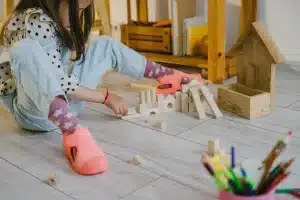The Benefits of Playing with Building Sets for Spatial Intelligence
Introduction
Building sets have long been a favorite toy for children of all ages. While they may seem simple, these sets offer a plethora of benefits, especially when it comes to developing spatial intelligence. Spatial intelligence refers to our ability to visualize and manipulate objects in our mind’s eye, and it plays a crucial role in various fields such as architecture, engineering, and mathematics. In this article, we will explore the many advantages that building sets provide in enhancing spatial intelligence.
Key Features:
- Enhanced Problem-Solving Skills: Building sets present children with a wide range of challenges, requiring them to think critically and devise solutions. By experimenting with different building arrangements, kids learn how to overcome obstacles, fostering problem-solving skills that will benefit them throughout life.
- Improved Spatial Awareness: Playing with building sets develops children’s spatial awareness by allowing them to create structures in three-dimensional space. This helps them grasp concepts such as depth, dimensions, and perspective, all of which are crucial for understanding geometry and spatial relationships.
- Fine Motor Skills Development: Building sets require precision and dexterity when manipulating small pieces. As children grasp, connect, and arrange the components, they improve their fine motor skills, hand-eye coordination, and spatial coordination simultaneously.
- Conceptual Understanding of Architecture and Engineering: Building sets often come with instruction manuals that encourage children to follow building plans. By doing so, they gain insight into the basic principles of architecture and engineering, including structural stability, balance, and design aesthetics.
- Enhanced Creativity and Imagination: While building sets may provide instructions, they also leave ample room for creativity and imagination. As children construct their own designs, they exercise their creative thinking processes, exploring various possibilities and experimenting with new ideas.
- Encourages Teamwork and Collaboration: Building sets are often enjoyable to play with in groups, fostering teamwork and collaboration among children. By working together to build complex structures, kids learn how to communicate effectively, share ideas, and leverage each other’s strengths.
- Cognitive Development: When engaging in spatial tasks with building sets, children develop cognitive skills such as logical reasoning, attention to detail, pattern recognition, and visualization. These skills are fundamental for problem-solving in various academic subjects, including mathematics, science, and computer programming.
- Preparation for Future Careers: Spatial intelligence is a sought-after skill in many professional fields. Playing with building sets at an early age can lay a solid foundation for a future career in architecture, engineering, design, or even the digital realm, where spatial thinking is increasingly valuable.
- Higher Academic Performance: Research has shown that children who engage in activities that promote spatial intelligence, such as playing with building sets, tend to perform better academically, particularly in mathematics and science. Strengthening spatial skills contributes to improved problem-solving abilities, analytical thinking, and overall cognitive development.
Conclusion
Building sets offer an array of benefits for developing spatial intelligence in children. Through the process of building and constructing, children enhance their problem-solving skills, spatial awareness, fine motor skills, and conceptual understanding of architecture and engineering. Moreover, these sets promote creativity, teamwork, and cognitive development, while also preparing children for future careers in spatially-driven disciplines. By engaging in playtime with building sets, children not only have a great deal of fun but also gain invaluable skills and knowledge that will shape their lifelong learning journey.





